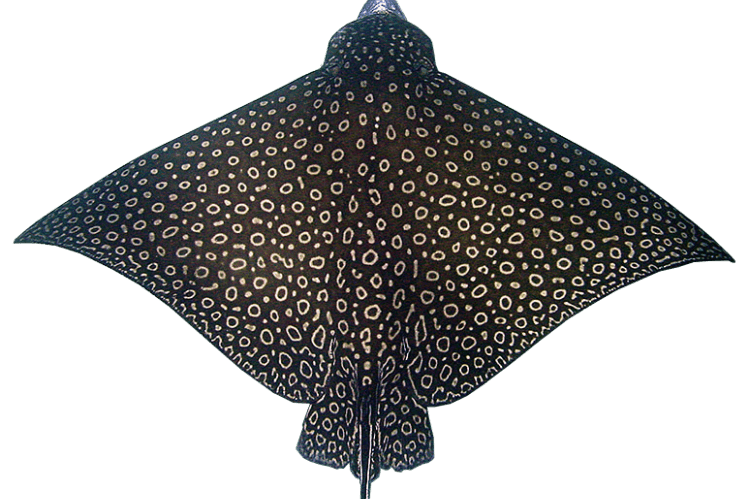Whitespotted Eagle Ray

Species Details
Aetobatus Narinari
Aetobatidae
Myliobatiformes
onshore, nearshore, surf
200 - 507 lbs.
70" - 132"
Whitespotted Eagle Ray (Aetobatus narinari) Fish Description
The Whitespotted Eagle Ray (Aetobatus narinari) is a type of eagle ray found in tropical waters around the world. This fish has a flat body that is dark greenish, greyish to almost black on top and white on the underside. As its name suggests, it is mostly covered with white spots on the top part. The Whitespotted Eagle Ray can also be identified through its long snout that is flat and rounded not unlike a duck’s bill. Like with all eagle rays, this ray has wide diamond-shaped pectoral discs that allow the fish to gracefully glide through the water. Aside from its markings and coloration, it can also be distinguished from other eagle rays through its very long, whip-like tail that is armed with two to six venomous spines.
Diet and Size
The Whitespotted Eagle Ray is the second largest (with the Manta Ray being the largest) eagle ray. It can grow to as much eleven feet in length; weighing as much as five hundred seven pounds.
The Whitespotted Eagle Ray is known to be a benthic foraging predator as it mostly stays on or near the seabed to hunt for food. It actually uses its “duckbill” to dig through the ocean floor as it searches for benthic invertebrates. While it mostly eats clams, oysters, shrimp, octopus, squids, and sea urchins, it may also sometimes prey on small bony fishes.
Interesting Facts
- The largest Whitespotted Eagle Ray on record measures a little more than eleven feet in length and weighs a whopping five hundred and seven pounds.
- It’s the second largest eagle ray, second only to the Manta Ray.
- It is an ovoviviparous fish, meaning its eggs develop hatch inside the mother, and are born live.
- They mostly swim together in groups of between three to sixteen individuals.
- Aside from humans, known predators of Whitespotted Eagle Rays are sharks—particularly Silvertips and Hammerheads.
- Sharks have been observed to follow Whitespotted Eagle Rays during the birthing season to feed on newly born pups.
- Due to their large size and white spots, Whitespotted Eagle Rays are a popular attraction in public aquariums.
- There have been reports of Whitespotted Eagle Rays jumping onto boats.
- Whitespotted Eagle Rays aren’t targeted by commercial fishers but they are often caught as a by-catch.
- The Whitespotted Eagle Ray is a popular gamefish among experienced anglers as it’s known to be a hard fighter and is quite a challenge to catch.
- Its meat is usually used for fishmeal and oil but rarely eaten due to its poor quality.
- The Whitespotted Eagle Rays produce loud sounds when caught.
- Although they rarely approach humans, Whitespotted Eagle Rays are still considered dangerous due to their venomous tail spines.
Whitespotted Eagle Ray Fishing Techniques
As earlier mentioned, Whitespotted Eagle Rays are a popular gamefish that is usually targeted not for their meat, but just for the fun of catching a hard fighter; so most of the eagle rays that are caught are usually released back to the water. That said, to make hook removal easier use a single circle hook. This will also inflict less damage to the fish. Also, make sure to keep the ray in the water and use a de-hooker to make the ordeal less stressful for the fish.
The best way to catch a Whitespotted Eagle ray is through surf fishing. With such a big fish and a strong swimmer to target, you must be ready for a long battle with the fish equipment-wise—especially if you happen to hook a larger one as they can easily snap an inferior line and/or rod. You will also need to go for lighter rods that have the same line ratings as heavier rods for you to be able to last what will surely be a long and tiring battle with this fish. Pair it with a powerful reel that is loaded with an 80-pound-test braided line and you’re good to go. As for the bait, the fish can easily be attracted to fresh strip baits.
Lastly, be careful of his tail at all times, especially when you’re releasing the fish back to the water as its venomous tail can inflict serious damage.
Habitat and Distribution
The Whitespotted Eagle Ray is a bottom-dweller that prefers sandy bottoms, commonly in bays and over coral reefs, typically in depths of approximately 200 feet and less. The ray can also be found worldwide in tropical and warm temperate waters. In US waters, you’ll be able to catch this fish along the coasts of the central Atlantic seaboard, specifically from North Carolina to Florida, as well as within the Gulf of Mexico. On the Pacific side, they could be found from southern California to Baja California in Mexico as well as in the waters of the Gulf of California.







